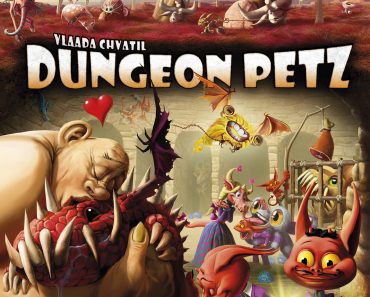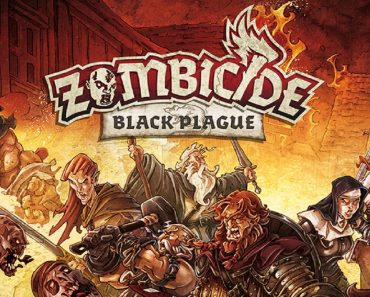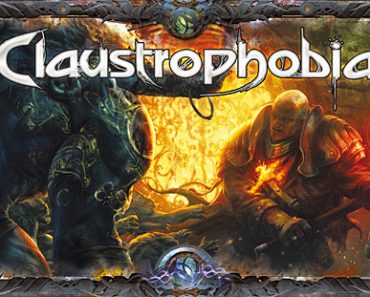Review
-
Game Rating
Introduction to Munchkin
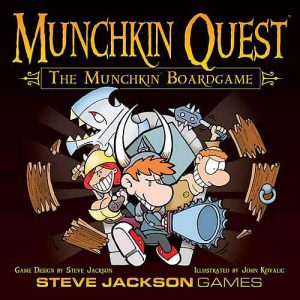 Munchkin is an incredibly popular dedicated deck card game which lovingly parodies other fantasy games and geek pop culture icons.
Munchkin is an incredibly popular dedicated deck card game which lovingly parodies other fantasy games and geek pop culture icons.
In this game, players will imitate dungeon crawlers from classic role playing games like Dungeons and Dragons or Pathfinder, with the goal of reaching level ten by defeating monsters. Along the way, players will find treasure, assist or betray one another, and encounter dangerous traps and curses in card form.
Munchkin was published by Steve Jackson Games, which has now also published dozens of expansions for the game riffing beloved franchises in the name of good clean fun.
Expansions such as Munchkin Adventure Time, Munchkin Conan, and Munchkin the Nightmare Before Christmas make spins on massively popular icons, while expansions like Munchkin Cthulhu and Munchkin Steampunk delve into comedic interpretations of niche genres.
The title of the game is a call to the role-playing game term “Munchkin”, which is a player who takes lighthearted games far too seriously and ruins the fun for everyone else by being aggressive, competitive, and exploiting flaws in the rules of games designed for fun rather than perfect balance.
This article will explore the basics of the rules and requirements for play, some special exceptions to the rules, basic strategies, and how the game is won. The general rules will be explained in adequate detail that a group of players should be able to pick up and play after reading.
Interested players should be aware that the game went through a massive rules overhaul in 2010, meaning pre-2010 versions of the game are not perfectly compatible with most new packs and expansions.
Despite this, the game has rather loose rules interpretation, and many classic cards can be brought into new versions with some flexibility. In other words, don’t be a munchkin about it. Have fun and enjoy!
Number of players, playtime, and sets required to play
Munchkin is designed for three to six players, with an average playtime of one to two hours per game. Most Munchkin sets are stand-alone and combinable, meaning that players can choose any set to begin play, and can mix-and-match cards from other sets as they please.
However, the creator of the game, Steve Jackson, does warn in the games official frequently asked questions section that mixing certain sets might damage the experience by muddling the tone and flavour of individual sets.
For example, Sci-fi themed sets may not meld well with Kung-fu movie themed sets in terms of tone or item/monster design. This is certainly up to personal taste, though, as some players might rather enjoy kung-fu science fiction.
Stand-alone Munchkin sets come in three major categories: Core, Deluxe, and Guest Art Editions. Core sets function as the backbone of the game’s product line. Each Core set represents a setting or “universe” of play. For example, Marvel Munchkin is a Core set which takes place in the Marvel comic book universe.
Deluxe packs are Core sets which include a higher-quality, mounted game board, summary rule sheets, and cut-out figurines for player characters. All of these are items that assist with the clarity of play for players or add to the visual atmosphere of the game, but are not necessary for play.
Guest Art Editions are generally Deluxe packs, but with unique art by guest artists which adds a fun, varied visual component to standard play. Many of the guest artists are comic book artists of significant renown, including Ian McGinty, the artist of Adventure Time, Steven Universe, and Powerpuff Girls comic series.
Though most Munchkin game boxes are stand-alone products, there are a good amount of smaller expansion sets which are intended to be added in to another box set. An example of such a set is, Munchkin 7: Cheat with Both Hands, which adds numerous rule-bending cards to mix up play.
Win conditions and Goals of Play
There are two possible victory conditions in Munchkin, one for each variant of play.
In standard Munchkin, the goal is to reach “Level 10” or to accumulate 10 counters on a character card.
In “epic” Munchkin, the goal is to reach “Level 20” instead of 10. In each round, players will seek to impede or assist other players as they each vie for available points during their turn.
Goals of individual rounds can change, as assisting another player in one round can pay off later. Beware, however, as betrayal and trickery is not only possible, but encouraged by the rules and special card text.
Most levels will be gained by defeating a monster during your turn, and in most cases you can only progress to the winning level (from level 9 to level 10 or level 19 to 20) by killing a monster.
Certain special cards can grant levels to help you reach level 9, but only a very select few allow you to actually win without killing a monster. As a result, killing monsters and preventing other players from killing monsters are a major goals of play, especially in the endgame.
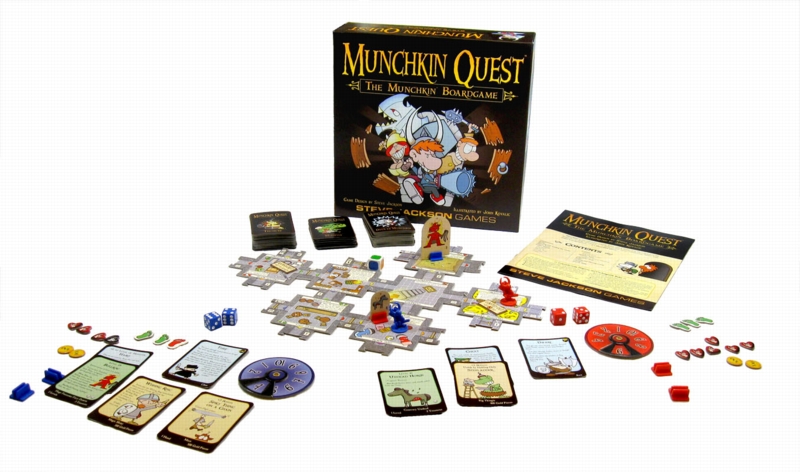
Set-up and General Rules of play
At least One full set of Munchkin is required for play. In addition, a six-sided die and 10 tokens per player (20 for epic Munchkin) will be required. In any Munchkin deck, there will be two types of cards, “Door” and “Treasure” cards, which should be separated into two decks and shuffled. After this has been done, each player should be dealt four cards from each deck.
Next to each deck, a separate, face-up, discard pile should be established.
In the case of a draw-out of a deck, all discards should be shuffled and placed back, face-down, as a fresh draw deck. Keep in mind it is against the rules for a player to look through a discard pile unless that player had a card that explicitly allows it. Only the top card on the discard pile is visible to all players at any time.
Cards have two positions (besides being in the deck or discard pile):
1. In Play
i. In Play cards should be placed face-up in front of the player who played them, visible to other players. “Race” and “Class” cards will stay in front of the player consistently, as will “Item” cards and a few special cards, such as “Continuing Curses.”
ii. Players cannot pick up cards that are in play once they have been played.
They can only be discarded or traded away if the player wishes to be rid of the card.
2. In Hand
i. Cards in hand do not effect play and cannot be tampered by other players, except with special cards. A player may have at most five cards in hand at the end of turn. Additional cards above the five card limit must either be played immediately or given to the player with the lowest level (the action of passing cards to the lowest level player is called the “charity” mechanic.)
At the beginning of the game, every character is treated as a Level 1 human with no class, and character sex must be declared at the beginning of play (for the purposes of clarity, the rules state that all Munchkin characters must be either male or female).
Once Door and Treasure cards have been dealt, players should immediately look at their hands. If a player’s hand contains a Race or Class card, they may put one of each type into play. In addition, players may place any currently usable items into play during this pre-game phase.
According to the official handbook, players should decide who plays first by rolling a die and arguing about the results. After this step has been completed, play proceeds to the left of the first player. The first player to reach Level 10 wins, but, as mentioned above, players must reach Level 10 by killing a monster unless a card explicitly states otherwise.
Players should keep in mind a few hard rules outlined in the official handbook. The following rules can only be broken in the case that a card explicitly states an override:
1. No event can reduce players below Level 1. Certain cards may lower a character’s combat strength below one. Negative levels in regards to win conditions do not exist.
2. Levels are attained after combat only if you kill a monster.
3. Rewards for defeating a monster cannot be collected until after combat is completed.
4. A monster must be killed to reach Level 10.
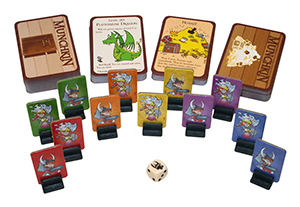
Turns, Phases, Actions, and Combat
Turns have a basic structure composed of three phases:
1. “Kick Open the Door”
i. The active player draws a card from the Door deck and immediately places it face up. Monster cards must be fought by the active player. Curse cards apply to the active player’s character immediately.
2. “Look for Trouble or Loot the Room”
i. Players who already fought a monster skip this phase completely.
ii. If a player did not fight a monster in the “Kick Open the Door” phase, that player can choose from one of these actions:
1. Look for Trouble: The active player places a monster from their hand and fights it just as if they had drawn a monster from the first phase.
2. Loot the Room: The active player draws a card from the Door deck without showing it to other players and places this card in their hand.
3. “Charity”
i. As mentioned above, players with more than five cards in their hand at this phase must either play cards until their hand is five cards or lower, or they must give their extra cards away to the player with the lowest level at the table.
ii. If the active player is the lowest level at the table or is tied for lowest level, all cards above the five card limit should be discarded.
Player actions follow a basic three-type-structure as well:
1. “Free actions,” which can be taken at any time:
a. Activating a curse from the hand.
b. Activating a “Hireling” or “Go Up a Level” card from the hand.
c. Discarding a Class or Race card from the In Play area.
2. “Non-combat actions,” which can be taken at any time a player is not in combat:
a. Trading items with other players who are not in combat themselves.
b. Changing equipped items.
c. Playing a card which has just been received.
3. “Turn only actions,” which can only be taken by the active player during their turn
a. Selling items for gold when not in combat.
b. Activating a new class or race.
c. Playing an item.
i. Note: most items are restricted to be activated outside of combat, but some single-use, or “one-shot,” items can be used during combat.
The basic structure of combat is rather straightforward, but can be complicated by the actions of other players. When a player fights a monster, they compare their combat strength against the monster’s combat strength. The character with the greater combat strength wins the combat encounter.
In the case of a tie, the monster will win the encounter. Combat strength is calculated by adding the character’s level plus bonuses and penalties from other cards. If a player wins, they can increase their character’s level by one. If they lose, they must run away (explained in detail below).
Most monsters will also allow the player to draw additional cards from the treasure pile upon victory. Some monsters may even grant bonus levels. Players should note that certain items may get rid of a monster without actually killing it, and such a victory does not grant the benefits of level up and treasure in most cases.
During combat, other players can play cards that effect the combat situation of the active player.
The most common of these cards are called “monster enhancers” and their effect is described on the card. Other players can use these to sabotage the combat of the active player. In addition to enhancers, there is a class of monsters called “wandering monsters” which allow other players to add another monster to the fight.
A player challenging multiple monsters needs to overcome their combined combat strength. Beware of cards that remove a single monster in multiple-monster fights, both monsters must be defeated in order to gather the victory benefits.
If the active player is unable to overcome the monster set before them, they may call for help from another player. Players can only be aided by one other player at a time. Doing so adds that player’s total combat strength to the active player’s total. Helpers do not gain a level from the active player’s victory, however, the active player can agree to split the treasure in any way they please.
Treasure deals should be done before the fight and must be followed through with. (Unfortunately, for the preservation of friendships and sanity, cheating on treasure deals is not allowed).
If the active player loses the fight, they must “run away.” Helpers in the fight must also participate individually in a running away phase if the fight is lost. Running away has a few steps which are as follows:
1. Roll the Die for each monster you are facing.
a. A five for more is considered an escape, unless another card is actively modifying this.
b. A five or less is considered being “caught” by the monster. The monster then proceeds to inflict “Bad Stuff” on the character(s) who is caught.
c. Bad Stuff will be explained on the individual monster card.
2. Resolve Bad Stuff from each monster that has caught a player, in the order it caught the player.
3. Resolve “Death” if death is listed in the “Bad Stuff” of a particular monster
a. Death means a player loses all their items. A player must keep their classes, race, and levels.
b. After all items have been set aside, the player whose character has died must lay out their hand and all the cards they had in play minus race, class, and special “hireling” and “cheat” cards. The other players in the game can choose one item from those lost. The rest are discarded. Pick of items goes from highest to lowest level around the play area.
c. On the active player’s next turn, they must draw four face down cards from the Treasure deck and the Door deck, as in the beginning of the game. Play proceeds as normal.
Items have some restrictions that players should be aware of. Items need to be “equipped” in order to grant benefits to the player who possesses them. Players can only equip one of each type of armour at a time, two one-handed weapons, and one two-handed weapon.
There are a very select few cards that break this rule. Players can “carry” as many items at a time as they would like. These items are suggested in the official handbook to be placed sideways so as not to confuse them with equipped items. Certain items may have unique restrictions which will be listed on the card itself.
One of the actions, “selling items for gold,” listed above warrants further exploration.
Almost all items have a listed gold value.
At any point during a player’s turn, except during combat, they may sell any number of items they wish. For each 1000 gold accumulated from the sale of these items, that player may add a level to their character. No change can be made from sales, so round increments of 1000 are strategically preferable in general in order to not waste card gold value. Not all treasures are sellable, only items with a listed value.
Victory
Victory is simple.
When a player reaches Level 10, they win the game. Helpers, because they do not receive levels from assisting another player, do not win even if they are responsible for the killing blow on the active player’s turn.
Variants to Play
Each Munchkin set adds new cards, and, therefore, new overrides to the rules. Sets can be combined freely, as can expansions. In addition to this, any Munchkin set can be modified to become “epic” Munchkin, as mentioned in the rules introduction. Epic Munchkin not only expands the level cap to Level 20, but it also adds in plenty of new features which can mix up play.
There are a few suggested play variants listed in the original handbook. One of these variants instructs the addition of a “Listen at the Door” phase which allows a player to draw a face down door card and choose whether they wish to play it or not.
If they choose not to play it, they can instead proceed to draw again and “Kick Down the Door” as usual. In addition to adding a phase, “Listening at the Door” allows players to draw only from the Treasure deck instead of the Door deck while “Looting the Room.”
Also suggested in the original handbook is a rule allowing helpers to share in victories, no matter their level at the time of the active player’s victory. This rule can encourage more helpful play, a quicker game, and a more positive play environment for player groups who desire such.
Basic Munchkin Strategies
New players may wish to consider the following basic strategies that can help them get ahead within the game. While Munchkin is designed specifically to discourage players being munchkin-ly and taking the game too seriously, it can be helpful for new players to have some basic advice so as not to get completely swept and prevented from any victory. The following are some collected strategy tips:
1. Avoid wasting valuable cards on very low level players. Since players cannot drop below level one, it is much more useful to keep valuable items for later in the game when it can prevent another player from winning by reaching higher levels.
2. Save “go up a level” cards (sometimes referred to by players as GUAL cards) for key moments in the game. Going up multiple levels at once can really shake things up in a player’s favour.
3. Be careful around Level 9. This level, understandably, will make other players wary of a player’s ability to win with a single successful victory in combat. It is sometimes a wise choice to begin a turn on Level 8, sell items before Kicking
Open the Door, and then face the challenge within for a single-turn win.
4. Don’t be afraid to keep cards in hand. Sometimes it is better and safer for powerful cards to remain out of the vision of other players.
5. Develop a good poker face. Body language cues can be a clue of important actions!
6. Try to keep track of when other players have used powerful cards. A player might be able to safely succeed in combat if other players have used their cards on previous player’s turns.
7. Don’t be afraid of bluffing and betrayal, these are core aspects of the game and sometimes betrayal can bring you victory. Other players are likely to betray and bluff as well, so beware!
Useful Resources
On the official Munchkin site, Steve Jackson has a very large F.A.Q. and Errata page. This can be particularly useful in addressing and settling rules disputes or unclear cards. While some cards encourage creativity and disagreement, there are indeed some cards that were misprints or oversights on the part of the creator.
